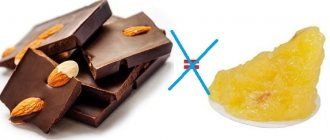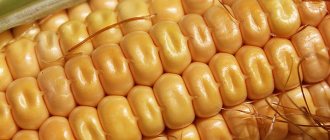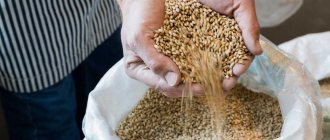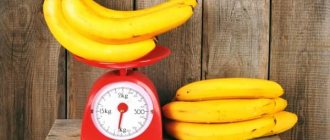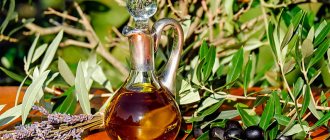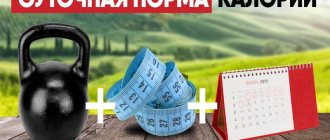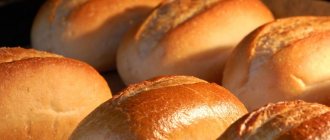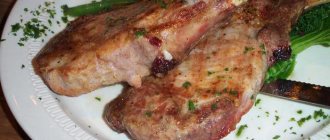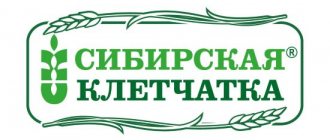Fruits, dried fruits and berries
Attention! To see the entire table, select Show 100 Records, or use the Previous and Next buttons to view the table in sections.
| Product | Calorie content | Squirrels | Fats | Carbohydrates |
| Apricots | 46 | 0,9 | 0 | 10,5 |
| Avocado | 223 | 1,9 | 23,5 | 6,7 |
| Quince | 38 | 0,6 | 0 | 8,9 |
| Cherry plum | 34 | 0,2 | 0 | 7,4 |
| A pineapple | 48 | 0,4 | 0 | 11,8 |
| Orange | 38 | 0,9 | 0 | 8,4 |
| Watermelon | 38 | 1 | 0 | 8 |
| Bananas | 91 | 1,5 | 0 | 22,4 |
| Cowberry | 40 | 0,7 | 0 | 8,6 |
| Grape | 69 | 0,4 | 0 | 17,5 |
| Cherry | 49 | 0,8 | 0 | 11,3 |
| Cherry (dried) | 292 | 1,5 | 0 | 73 |
| Blueberry | 37 | 1 | 0 | 7,7 |
| Pomegranate | 52 | 0,9 | 0 | 11,8 |
| Grapefruit | 35 | 0,9 | 0 | 7,3 |
| Pear | 42 | 0,4 | 0 | 10,7 |
| Pear (dried) | 246 | 2,3 | 0 | 62,1 |
| Blackberry | 33 | 2 | 0 | 5,3 |
| Strawberries | 41 | 1,8 | 0 | 8,1 |
| Raisins with seeds (dried) | 276 | 1,8 | 0 | 70,9 |
| Kishmish raisins (dried) | 279 | 2,3 | 0 | 71,2 |
| Figs | 56 | 0,7 | 0 | 13,9 |
| Kalina | 32 | 0,5 | 0 | 4,6 |
| Kiwi | 61 | 1 | 0 | 11 |
| Dogwood | 45 | 1 | 0 | 9,7 |
| Cranberry | 28 | 0,5 | 0 | 4,8 |
| Gooseberry | 44 | 0,7 | 0 | 9,9 |
| Dried apricots | 272 | 5,2 | 0 | 65,9 |
| Lemon | 31 | 0,9 | 0 | 3,6 |
| Mandarin | 38 | 0,8 | 0 | 8,6 |
| Raspberries | 41 | 0,8 | 0 | 9 |
| Cloudberry | 31 | 0,8 | 0 | 6,8 |
| Sea buckthorn | 30 | 0,9 | 0 | 5,5 |
| Peaches | 44 | 0,9 | 0 | 10,4 |
| Peaches (dried) | 275 | 3,0 | 0 | 68,5 |
| Rowan garden | 58 | 1,4 | 0 | 12,5 |
| Rowan chokeberry | 54 | 1,5 | 0 | 12 |
| Garden plum | 43 | 0,8 | 0 | 9,9 |
| Dried plum (prunes) | 264 | 2,3 | 0 | 65,6 |
| White currant | 39 | 0,3 | 0 | 8,7 |
| Red currants | 38 | 0,6 | 0 | 8 |
| Black currant | 40 | 1,0 | 0 | 8,0 |
| Dried apricots | 278 | 5 | 0 | 67,5 |
| Dates | 281 | 2,5 | 0 | 72,1 |
| Persimmon | 62 | 0,5 | 0 | 15,9 |
| Cherries | 52 | 1,1 | 0 | 12,3 |
| Blueberry | 40 | 1,1 | 0 | 8,6 |
| Fresh rosehip | 101 | 1,6 | 0 | 24 |
| Rosehip (dried) | 253 | 4,0 | 0 | 60 |
| Mulberry | 53 | 0,7 | 0 | 12,7 |
| Apples | 46 | 0,4 | 0 | 11,3 |
| Apples (dried) | 273 | 3,2 | 0 | 68 |
Greens and vegetables
Attention! To see the entire table, select Show 50 Records, or use the Previous and Next buttons to view the table in sections.
| Product | Calorie content | Squirrels | Fats | Carbohydrates |
| Eggplant | 24 | 0,6 | 0,1 | 5,5 |
| Swede | 37 | 1,2 | 0,1 | 8,1 |
| Green peas | 72 | 5,0 | 0,2 | 13,3 |
| Zucchini | 27 | 0,6 | 0,3 | 5,7 |
| White cabbage | 28 | 1,8 | 0 | 5,4 |
| Red cabbage | 31 | 1,8 | 0 | 6,1 |
| Cauliflower | 29 | 2,5 | 0 | 4,9 |
| Potato | 83 | 2 | 0,1 | 19,7 |
| Green onion (feather) | 22 | 1,3 | 0 | 4,3 |
| Leek | 40 | 3 | 0 | 7,3 |
| Bulb onions | 43 | 1,7 | 0 | 9,5 |
| Red carrots | 33 | 1,3 | 0,1 | 7 |
| Ground cucumbers | 15 | 0,8 | 0 | 3 |
| Greenhouse cucumbers | 10 | 0,7 | 0 | 1,8 |
| Sweet green pepper | 23 | 1,3 | 0 | 4,7 |
| Sweet red pepper | 27 | 1,3 | 0 | 5,7 |
| Parsley (greens) | 45 | 3,7 | 0 | 8,1 |
| Parsley (root) | 47 | 1,5 | 0 | 11 |
| Rhubarb (petiole) | 16 | 0,7 | 0 | 2,9 |
| Radish | 20 | 1,2 | 0 | 4,1 |
| Radish | 34 | 1,9 | 0 | 7 |
| Turnip | 28 | 1,5 | 0 | 5,9 |
| Salad | 14 | 1,5 | 0 | 2,2 |
| Beet | 48 | 1,7 | 0 | 10,8 |
| Tomatoes (ground) | 19 | 0,6 | 0 | 4,2 |
| Tomatoes (greenhouse) | 14 | 0,6 | 0 | 2,9 |
| Green bean | 32 | 4 | 0 | 4,3 |
| Horseradish | 71 | 2,5 | 0 | 16,3 |
| Cheremsha | 34 | 2,4 | 0 | 6,5 |
| Garlic | 106 | 6,5 | 0 | 21,2 |
| Spinach | 21 | 2,9 | 0 | 2,3 |
| Sorrel | 28 | 1,5 | 0 | 5,3 |
Chemical composition and nutritional value of boiled buckwheat per 100 grams
The product has a rich chemical composition. 100 g of buckwheat contains the following vitamins:
- A - 2 mcg;
- E - 0.8 mg;
- beta-carotene - 0.01 mg;
- RR - 4.2 mg;
- B1 - 0.43 mg;
- B2 - 0.2 mg;
- B3 - 0.9 mg;
- B4 - 20.1 mg;
- B5 - 0.4 mg;
- B6 - 0.4 mg;
- B9 - 14 mcg.
Among the minerals beneficial to the body:
- boron - 350 mcg;
- iron - 6.7 mg;
- iodine - 3.3 mcg;
- potassium - 380 mg;
- calcium - 20 mg;
- cobalt - 3.1 mcg;
- silicon - 81 mg;
- magnesium - 200 mg;
- manganese - 1.56 mg;
- copper - 640 mg;
- sodium - 3 mg;
- nickel - 10.1 μg;
- selenium - 8.3 mcg;
- sulfur - 88 mg;
- phosphorus - 298 mg;
- fluorine - 23 mcg;
- chlorine - 33 mg;
- chromium - 4 mcg;
- zinc - 2.05 mg.
Buckwheat also contains the following plant compounds:
- routine;
- quercetin;
- vitexin;
- D-chiroinositol.
Glycemic index and KBJU of buckwheat boiled in water
The calorie content of the product in dry form is 308 kcal per 100 g, but during the cooking process the energy value of buckwheat decreases - 90 kcal per 100 g.
If there is no kitchen scale, calorie content is measured using cutlery. So, in 1 tbsp. l. - 77 kcal (per 25 g), and in the tea room - 25 kcal (per 8 g). In 1 tbsp. (250 ml) - 210 g of buckwheat, which means the calorie content of the finished dish is 190 kcal.
Attention! The calorie content and ratio of BZHU depends on the method of preparing the product.
If porridge is cooked in water without salt, its calorie content is 90 kcal, with salt - 103 kcal. And the calorie content of porridge cooked with milk will be 200 kcal.
BJU of buckwheat boiled in water:
- proteins - 3.4;
- fats - 0.6 g;
- carbohydrates - 19.9 g;
- fiber - 0.3 g.
100 g of buckwheat boiled in water, despite its low calorie content, contains 16% proteins, 3% fats and 24% carbohydrates.
The glycemic index of buckwheat is 40-50 units.
Attention! The product has a low glycemic index. This means that eating porridge does not cause changes in blood sugar, and the soluble carbohydrates in the composition, on the contrary, help lower it after eating.
Mushrooms and legumes
| Product | Calorie content | Squirrels | Fats | Carbohydrates |
| White (fresh) | 25 | 3,2 | 0,7 | 1,6 |
| White (dried) | 209 | 27,6 | 6,8 | 10 |
| Beans | 58 | 6 | 0,1 | 8,3 |
| Peas | 323 | 23 | 1,6 | 57,7 |
| Whole peas | 303 | 23 | 1,2 | 53,3 |
| Boletus mushrooms (fresh) | 31 | 2,3 | 0,9 | 3,7 |
| Boletus (fresh) | 31 | 3,3 | 0,5 | 3,4 |
| Soybeans | 395 | 34,9 | 17,3 | 26,5 |
| Russula (fresh) | 17 | 1,7 | 0,3 | 1,4 |
| Beans | 309 | 22,3 | 1,7 | 54,5 |
| Lentils | 310 | 24,8 | 1,1 | 53,7 |
Eggs
| Product | Calorie content | Squirrels | Fats | Carbohydrates |
| Chicken egg | 157 | 12,7 | 11,5 | 0,7 |
| Egg powder | 542 | 45 | 37,3 | 7,1 |
| Protein powder | 336 | 73,3 | 1,8 | 7 |
| Dry yolk | 623 | 34,2 | 52,2 | 4,4 |
| Quail egg | 168 | 11,9 | 13,1 | 0,6 |
Principles of nutrition
The diet should be complete, namely balanced in the number of proteins, fats and carbohydrates. It is also equally important that the menu for diabetes contains a sufficient number of vitamin components and microelements.
The next principle is that the caloric content of food consumed must correspond to energy expenditure. This is what will make it possible to ensure an optimal degree of performance and maintain optimal body weight, which is also very important for any diabetic.
The diet over a 24-hour period is strongly recommended to be distributed taking into account the duration of action and the total period of time to achieve the maximum possible hypoglycemic effect of insulin. The same applies to tablet medications, which are aimed at ensuring optimal blood sugar levels. And, of course, we should not forget that food should be as varied as possible, nutritious and simply enjoyable - all this affects the digestion process.
The food each of us eats includes proteins, fats and carbohydrates, as well as vitamins, minerals and water. In the process of assimilation of food, the amount of energy necessary for the optimal functioning of the body is released. We are talking, in particular, about maintaining optimal body temperature, breathing, and blood circulation.
No less important is the replenishment of energy costs that are associated with the implementation of any work.
Experts point out that:
- the energy contained in food is expressed in kilocalories, which are designated as kcal;
- in the process of breaking down 1 g of carbohydrate and 1 g of protein, 4 kcal are released. While 1 g of fat can provide a person with 9 kcal of energy, which is very important for diabetes;
- the combination and total amount of proteins, fats and carbohydrates in the diet for a given disease should meet all the needs of even a healthy person.
Treating type 2 diabetes with baking soda
As part of the compensation, 50 or 60% of daily calorie needs are met from carbohydrate foods. From 15 to 20% - from protein foods and no more than 25, but not less than 30% - from fats. At the same time, if overweight is identified, it is strongly recommended to reduce the daily calorie ratio by minimizing fat intake.
Fish and seafood
| Product | Calorie content | Squirrels | Fats | Carbohydrates |
| Gobies | 145 | 12,8 | 8,1 | 5,2 |
| Pink salmon | 147 | 21 | 7 | 0 |
| Chum salmon caviar granular | 251 | 31,6 | 13,8 | 0 |
| Breakout bream caviar | 142 | 24,7 | 4,8 | 0 |
| Pollock caviar, punched | 131 | 28,4 | 1,9 | 0 |
| Sturgeon caviar granular | 203 | 28,9 | 9,7 | 0 |
| Flounder | 88 | 16,1 | 2,6 | 0 |
| Squid | 75 | 18 | 0,3 | 0 |
| crucian carp | 87 | 17,7 | 1,8 | 0 |
| Carp | 96 | 16 | 3.6 | 0 |
| Chum salmon | 138 | 22 | 5.6 | 0 |
| Smelt | 91 | 15.5 | 3.2 | 0 |
| Crab | 69 | 16 | 0,5 | 0 |
| Shrimp | 83 | 18 | 0,8 | 0 |
| Far Eastern shrimp | 134 | 28,7 | 1,2 | 0 |
| Icy | 75 | 15.5 | 1.4 | 0 |
| Bream | 105 | 17.1 | 4.1 | 0 |
| Salmon | 219 | 20.8 | 15.1 | 0 |
| Macrurus | 60 | 13.2 | 0.8 | 0 |
| Lamprey | 166 | 14.7 | 11.9 | 0 |
| Pollock | 70 | 15.9 | 0.7 | 0 |
| capelin | 157 | 13.4 | 11.5 | 0 |
| Sea kale | 5 | 0,9 | 0,2 | 3 |
| Navaga | 73 | 16.1 | 1 | 0 |
| Burbot | 81 | 18.8 | 0.6 | 0 |
| Marbled notothenia | 156 | 14.8 | 10.7 | 0 |
| Sea bass | 117 | 17.6 | 5.2 | 0 |
| River perch | 82 | 18.5 | 0.9 | 0 |
| Sturgeon | 164 | 16.4 | 10.9 | 0 |
| Halibut | 103 | 18.9 | 3 | 0 |
| Pasta "Ocean" | 137 | 18,9 | 6,8 | 0 |
| Cod liver | 613 | 4,2 | 65,7 | 0 |
| Blue whiting | 72 | 16.1 | 0.9 | 0 |
| Saber fish | 110 | 20.3 | 3.2 | 0 |
| Caspian fisherman | 98 | 19.2 | 2.4 | 0 |
| Carp | 121 | 18.4 | 5.3 | 0 |
| Large saury | 262 | 18.6 | 20.8 | 0 |
| Small saury | 143 | 20.4 | 0.8 | 0 |
| Salaka | 121 | 17.3 | 5.6 | 0 |
| Herring | 242 | 17.7 | 19.5 | 0 |
| Whitefish | 144 | 19 | 7.5 | 0 |
| Mackerel | 153 | 18 | 9 | 0 |
| Som | 144 | 16.8 | 8.5 | 0 |
| Horse mackerel | 119 | 18.5 | 5 | 0 |
| Sterlet | 320 | 17 | 6.1 | 0 |
| Zander | 83 | 19 | 0.8 | 0 |
| Trepang | 35 | 7,3 | 0,6 | 0 |
| Cod | 75 | 17.5 | 0.6 | 0 |
| Tuna | 96 | 22,7 | 0,7 | 0 |
| coal fish | 158 | 13.2 | 11.6 | 0 |
| Sea eel | 94 | 19.1 | 1.9 | 0 |
| Acne | 333 | 14.5 | 30.5 | 0 |
| Hake | 86 | 16.6 | 2.2 | 0 |
| Pike | 82 | 18.8 | 0.7 | 0 |
| Ide | 117 | 18.2 | 0.3 | 0 |
Calorie norm: online calculator
To calculate caloric intake you need to know the following data:
- Weight (in kg)
- Height (in cm)
- Age
- Activity factor
- Percentage of deficit or surplus
After entering the values you will receive the following data:
- Calorie norm for weight loss (calorie deficit)
- Calorie intake for weight maintenance
- Calorie intake for weight gain (calorie surplus)
How to determine the activity coefficient:
- 1.2 – minimal activity (lack of physical activity, sedentary work, minimum movement)
- 1.375 – light activity (light workouts or walks, light daily activity during the day)
- 1.46 – average activity (workouts 4-5 times a week, good activity throughout the day)
- 1.55 – above average activity (intensive training 5-6 times a week, good activity throughout the day)
- 1.64 – increased activity (daily training, high daily activity)
- 1.72 – high activity (daily ultra-intensive training and high daily activity)
- 1.9 – very high activity (usually we are talking about athletes during the period of competitive activity)
When determining activity, take into account not training, but general daily activity (work, movement during the day, other activity). If, for example, you train 3 times a week for 60 minutes at an average pace, but spend most of the day sitting, then choose minimal activity. If it happens differently on different days, then choose the approximate average activity per day over a week period.
How to determine the percentage of deficit or surplus:
- By default we recommend taking 20%.
- If you do not want to force the process of losing weight or gaining weight, then choose 10-15%.
- If the BMI (body mass index) is more than 30, then you can take a deficit of 25-30% (after normalizing your weight, reduce the deficit to 20%).
Please note that the calorie calculator for men and women is different. Fields marked with asterisks are required. Calorie norms are calculated immediately for weight loss (calorie deficit), for weight gain (calorie surplus), and for maintaining/preserving weight. You choose values depending on your goals.
Calorie intake is calculated using the Harris-Benedict formula, which is recognized as the most accurate to date. For more information on how values are calculated using this formula, see the article on CALORIE COUNTING.
Meat, offal, poultry
| Product | Calorie content | Squirrels | Fats | Carbohydrates |
| Mutton | 203 | 16,3 | 15,3 | 0 |
| Lamb Kidneys | 77 | 13,6 | 2,5 | 0 |
| Lamb Liver | 101 | 18,7 | 2,9 | 0 |
| Lamb Heart | 82 | 13,5 | 2,5 | 0 |
| Beef | 187 | 18,9 | 12,4 | 0 |
| Beef Brains | 124 | 9,5 | 9,5 | 0 |
| Beef liver | 98 | 17,4 | 3,1 | 0 |
| Beef Kidneys | 66 | 12,5 | 1,8 | 0 |
| Beef Udder | 173 | 12,3 | 13,7 | 0 |
| Beef Heart | 87 | 15 | 3 | 0 |
| Beef Tongue | 163 | 13,6 | 12,1 | 0 |
| Goose | 364 | 16,1 | 33,3 | 0 |
| Turkey | 197 | 21,6 | 12 | 0,8 |
| horsemeat | 143 | 20,2 | 7 | 0 |
| Rabbit | 199 | 20,7 | 12,9 | 0 |
| Chicken | 165 | 20,8 | 8,8 | 0,6 |
| Pork kidneys | 80 | 13 | 3,1 | 0 |
| Pork liver | 108 | 18,8 | 3,6 | 0 |
| Pork lean | 316 | 16,4 | 27,8 | 0 |
| Pork is fatty | 489 | 11,4 | 49,3 | 0 |
| Pork heart | 89 | 15,1 | 3,2 | 0 |
| Veal | 90 | 19,7 | 1,2 | 0 |
| Duck | 346 | 16,5 | 61,2 | 0 |
| Chickens | 156 | 18,7 | 7,8 | 0,4 |
| Pork tongue | 208 | 14,2 | 16,8 | 0 |
Sausages, canned meat
| Product | Calorie content | Squirrels | Fats | Carbohydrates |
| Boiled sausage Diabetic | 254 | 12,1 | 22,8 | 0 |
| Boiled sausage Dietary | 170 | 12,1 | 13,5 | 0 |
| Boiled sausage Doctorskaya | 260 | 13,7 | 22,8 | 0 |
| Boiled sausage Lyubitelskaya | 301 | 12,2 | 28 | 0 |
| Boiled sausage Milk | 252 | 11,7 | 22,8 | 0 |
| Boiled sausage Separate | 228 | 10,1 | 20,1 | 1,8 |
| Boiled veal sausage | 316 | 12,5 | 29,6 | 0 |
| Boiled-smoked Amateur | 420 | 17,3 | 39 | 0 |
| Boiled-smoked Cervelat | 360 | 28,2 | 27,5 | 0 |
| Ham | 279 | 22,6 | 20,9 | 0 |
| Raw smoked brisket | 632 | 7,6 | 66,8 | 0 |
| Beef stew | 232 | 16,8 | 18,3 | 0 |
| Tourist breakfast (beef) | 176 | 20,5 | 10,4 | 0 |
| Tourist breakfast (pork) | 206 | 16,9 | 15,4 | 0 |
| Sausage mince | 213 | 15,2 | 15,7 | 2,8 |
| Raw smoked loin | 467 | 10,5 | 47,2 | 0 |
| Pork sausages | 332 | 10,1 | 31,6 | 1,9 |
| Dairy sausages | 277 | 12,3 | 25,3 | 0 |
| Russian sausages | 220 | 12 | 19,1 | 0 |
| Pork sausages | 324 | 11,8 | 30,8 | 0 |
| Semi-smoked Krakow | 466 | 16,2 | 44,6 | 0 |
| Semi-smoked Minsk | 259 | 23 | 17,4 | 2,7 |
| Semi-smoked Poltavskaya | 417 | 16,4 | 39 | 0 |
| Semi-smoked Ukrainian | 376 | 16,5 | 34,4 | 0 |
| Pork stew | 349 | 14,9 | 32,2 | 0 |
| Raw smoked Amateur | 514 | 20,9 | 47,8 | 0 |
| Raw smoked Moscow | 473 | 24,8 | 41,5 | 0 |
Dairy
| Product | Calorie content | Squirrels | Fats | Carbohydrates |
| Cow's milk cheese | 260 | 17,9 | 20,1 | 0 |
| Yogurt nat. 1.5% fat | 51 | 5 | 1,5 | 3,5 |
| Low-fat kefir | 30 | 3 | 0,1 | 3,8 |
| Full fat kefir | 59 | 2,8 | 3,2 | 4,1 |
| Milk | 58 | 2,8 | 3,2 | 4,7 |
| Acidophilus milk | 83 | 2,8 | 3,2 | 10,8 |
| Whole milk powder | 475 | 25,6 | 25 | 39,4 |
| Condensed milk | 135 | 7 | 7,9 | 9,5 |
| Condensed milk with sugar | 315 | 7,2 | 8,5 | 56 |
| Curdled milk | 58 | 2,8 | 3,2 | 4,1 |
| Ryazhenka | 85 | 3 | 6 | 4,1 |
| Cream 10% | 118 | 3 | 10 | 4 |
| Cream 20% | 205 | 2,8 | 20 | 3,6 |
| Sour cream 10% | 116 | 3 | 10 | 2,9 |
| Sour cream 20% | 206 | 2,8 | 20 | 3,2 |
| Special cheeses and curd mass | 340 | 7,1 | 23 | 27,5 |
| Russian cheese | 371 | 23,4 | 30 | 0 |
| Dutch cheese | 361 | 26,8 | 27,3 | 0 |
| Swiss cheese | 396 | 24,9 | 31,8 | 0 |
| Poshekhonsky cheese | 334 | 26 | 26,5 | 0 |
| Processed cheese | 226 | 24 | 13,5 | 0 |
| Fat cottage cheese | 226 | 14 | 18 | 1,3 |
| Cottage cheese semi-fat | 156 | 16,7 | 9 | 1,3 |
| Low-fat cottage cheese | 86 | 18 | 0,6 | 1,5 |
Flour products, cereals
| Product | Calorie content | Squirrels | Fats | Carbohydrates |
| Baranki | 312 | 10,4 | 1,3 | 68,7 |
| Buckwheat core | 329 | 12,6 | 2,6 | 68 |
| Buckwheat done | 326 | 9,5 | 1,9 | 72,2 |
| Hercules | 355 | 13,1 | 6,2 | 65,7 |
| Potato starch | 300 | 0,1 | 0,0 | 79,6 |
| Corn grits | 335 | 8,3 | 1,2 | 75 |
| Semolina | 326 | 11,3 | 0,7 | 73,3 |
| Premium wheat flour | 327 | 10,3 | 0,9 | 74,2 |
| Wheat flour, grade I | 329 | 10,6 | 1,3 | 73,2 |
| Wheat flour, grade II | 328 | 11,7 | 1,8 | 70,8 |
| Rye flour | 326 | 6,9 | 1,1 | 76,9 |
| Oatmeal | 345 | 11,9 | 5,8 | 65,4 |
| Pearl barley | 324 | 9,3 | 1,1 | 73,7 |
| Millet | 334 | 12 | 2,9 | 69,3 |
| Wheat "Poltavskaya" | 325 | 12,7 | 1,1 | 70,6 |
| Rice | 323 | 7 | 0,6 | 73,7 |
| Butter pastries | 297 | 7,6 | 4,5 | 60 |
| Drying | 330 | 11 | 1,3 | 73 |
| Wheat crackers | 331 | 11,2 | 1,4 | 72,4 |
| Cream crackers | 397 | 8,5 | 10,6 | 71,3 |
| Oatmeal | 357 | 12,2 | 5,8 | 68,3 |
| Rye bread | 214 | 4,7 | 0,7 | 49,8 |
| Millet bread. from grade I flour | 254 | 7,7 | 2,4 | 53,4 |
| Barley | 322 | 10,4 | 1,3 | 71,7 |
Optimal food
To get only benefits from food, you need to buy natural products. A woman or man who is losing or gaining weight needs the following nutrients:
- Proteins (lean meat, fish, eggs, legumes) are involved in the construction of new tissue, support recovery processes, and help increase muscle fiber. Proteins should take up 1/3 of the daily diet.
- Complex carbohydrates (buckwheat, oatmeal, millet, chickpeas, peas, bran) provide energy and activate brain activity. This group of nutrients should make up ½ of the daily menu.
- Unrefined fats (eggs, avocados, walnuts, almonds, fatty fish, olive oil) are also necessary for the body, but their amount should not exceed 1 g/1 kg of total weight.
- Fiber (bran, grains, vegetables, fruits) improves digestion.
- Vitamins strengthen the immune system and have a beneficial effect on the functionality of the body.
- Minerals are necessary for the construction of tissues, water metabolism, and enzymatic processes.
Expert opinion
Evgeniy Kislitsa
Practicing surgeon. Certified massage master. Two-time vice-champion and heavyweight champion of regional kettlebell lifting competitions.
Fiber has a beneficial effect on the functioning of the gastrointestinal tract, as it stimulates rhythmic contractions of the intestinal wall (peristalsis) and allows physiological control of the balance of intestinal microflora. The latter is necessary for normal digestion and the functioning of the immune system (a significant proportion of immunity is formed due to appropriate reactions in the intestinal cavity). Minerals, in addition to these functions, ensure the transmission of nerve impulses between cells. Such reactions ensure the functioning of all organs in the body. The role of minerals is especially important for the normal functioning of the heart (heart rate). It is also due to sodium that the filtration apparatus of the kidneys functions, due to which urine is formed and excreted from the body.
Interesting! Bean products, in addition to containing complex carbohydrates, are rich in plant proteins, so they can be used not only as a source of essential carbohydrates, but also proteins.
In addition, you should supplement your diet with foods rich in organic acids, tannins, flavonoids, etc.
For weight loss
Properly selected products will help a person speed up fat burning:
- Tomatoes, cucumbers, white fish, oranges, grapefruits contain few calories.
- Oatmeal, grade A pasta, beans, wholemeal bread, and apples will satisfy your hunger.
- Milk (0.1%), lentils, salad, berries do not increase glucose levels in the body.
- Cottage cheese (low fat), chicken offal, seafood, and tuna contain little fat.
- Olive oil, flax oil, almonds, and avocado contain fatty acids.
- Apples, carrots, paprika, celery, sugar-free dairy desserts, fruit purees, and berries have a pleasant taste and texture. In addition, they are rich in vitamin and mineral compounds, improve the functioning of the gastrointestinal tract and contain few calories.
- Lingonberries, berry fruit drinks, and celery have a diuretic effect, so they not only allow you to remove excess fluid from the body, but also have a beneficial effect on kidney function.
- Bananas, dietary milk products, bread, nuts, and dried fruits are used as a snack.
- Cheese, low-fat cottage cheese, dietary fish, egg whites, and beans will speed up weight loss and preserve muscle mass.
And dark chocolate (from 75%), dates, and nuts provoke the production of the joy hormone.
Important! Those who have diseases of the gastrointestinal tract should not get carried away with dark chocolate. After all, it irritates the mucous membrane of the intestines and stomach, which can lead to exacerbation of chronic diseases of the digestive organs.
Nutrition for weight gain
To gain weight faster, you need to increase the amount of protein and carbohydrate foods in the menu. Sources of protein: seafood, dietary meat, fish, milk, dairy products. Chicken is ideal for this purpose; it is quickly digested, so it can provide muscle tissue with the proteins necessary for its growth and recovery faster than other types of meat.
To recharge your energy, it is recommended to eat cereals, vegetables, and fruits. And crispbreads and bran bread contain healthy fiber.
Don't forget about fats: olive, sesame oil, seeds, nuts, etc.
This is interesting! To speed up the process of gaining muscle mass, it is recommended to take sports nutrition, vitamins, and minerals.
Expert opinion
Evgeniy Kislitsa
Practicing surgeon. Certified massage master. Two-time vice-champion and heavyweight champion of regional kettlebell lifting competitions.
To accelerate muscle gain and increase strength, it is recommended to use protein, creatine, BCAA (a complex of essential amino acids), amino acid complexes (including essential and non-essential). Protein (shakes, bars, etc.) allows you to deliver the necessary protein to the cells within 20-30 minutes. It is recommended to use protein isolate. It contains more protein and fewer calories by reducing the amount of carbohydrates. Protein concentrate is more suitable for those who are less calorie conscious or who are dieting to gain calories from concentrated protein supplements. However, the cost of protein isolate is higher than that of concentrate. BCAA allows you to provide the body with amino acids, which play a primary role in the restoration and growth of muscle cells. Moreover, this supplement contains virtually no calories. However, the effectiveness of its use is still disputed among professionals. The amino acid complex represents proteins split into monomers (structural units). This allows them to be absorbed by the body faster and does not waste time and energy breaking down proteins from protein supplements. However, the cost of an amino acid complex is often not inferior to protein. Creatine is a sports supplement that accelerates energy metabolism in muscle tissue and supplies it with energy. But creatine causes muscles to retain water, which, on the one hand, increases their volume, and on the other, leads to unnecessary weight gain. However, it is necessary to take creatine strictly for a certain time, and already 1-2 weeks after stopping its use, the liquid leaves the tissues. But after stopping taking the sports supplement, there is a decrease in strength and overall endurance. This is observed until the body gets used to “working” without the use of creatine from the outside.
Nuts
| Product | Calorie content | Squirrels | Fats | Carbohydrates |
| Apricot kernel | 440 | 14 | 27,7 | 56,3 |
| Peanuts | 551 | 26,3 | 45,2 | 9,8 |
| Walnut | 648 | 13,8 | 61,3 | 10,2 |
| Pine nut | 270 | 21 | 63,9 | 15,1 |
| Almond | 645 | 18,6 | 57,7 | 13,6 |
| sunflower seed | 577 | 20,7 | 52,9 | 4 |
| Pistachios | 318 | 18 | 16 | 54 |
| Hazelnut | 704 | 16,1 | 66,9 | 9,9 |
Confectionery, sweets
| Product | Calorie content | Squirrels | Fats | Carbohydrates |
| Waffles with fruit fillings | 342 | 3,2 | 2,8 | 80,1 |
| Waffles with fat fillings | 530 | 3,4 | 30,2 | 64,7 |
| Fruit dragee | 384 | 3,7 | 10,2 | 73,1 |
| Marshmallow | 299 | 0,8 | 0 | 78,3 |
| Iris | 387 | 3,3 | 7,5 | 81,8 |
| Caramel | 296 | 0 | 0,1 | 77,7 |
| Chocolate-eyed candies | 396 | 2,9 | 10,7 | 76,6 |
| Marmalade | 296 | 0 | 0,1 | 77,7 |
| Honey | 308 | 0,8 | 0 | 80,3 |
| Paste | 305 | 0,5 | 0 | 80,4 |
| Puff pastry with cream | 544 | 5,4 | 38,6 | 46,4 |
| Puff pastry with fruit filling | 454 | 5,7 | 25,6 | 52,7 |
| Sponge cake | 344 | 4,7 | 9,3 | 84,4 |
| Gingerbread | 336 | 4,8 | 2,8 | 77,7 |
| Sugar | 374 | 0,3 | 0 | 99,5 |
| Sponge cake | 386 | 4,7 | 20 | 49,8 |
| Almond cake | 524 | 6,6 | 35,8 | 46,8 |
| Tahini halva | 510 | 12,7 | 29,9 | 50,6 |
| Sunflower halva | 516 | 11,6 | 29,7 | 54 |
| Milk chocolate | 547 | 6,9 | 35,7 | 52,4 |
| Dark chocolate | 540 | 5,4 | 35,3 | 52,6 |
Fats in foods: functions, types
There is a false misconception that it is better to completely exclude fats from the diet (especially during weight loss). But that's not true. Scientists have proven that they are:
- provide the greatest amount of energy;
- supply elements important for the functioning of the body;
- help with the absorption of vitamins.
Research has shown that not all fats are created equal. Specifically, they fall into two categories:
- Vegetable . Pros: the presence of unsaturated (healthy) fatty acids (for example, Omega-3) and the absence of harmful cholesterol. Moreover, filling the diet with such products helps remove cholesterol and prevent the development of atherosclerosis. After entering the body, vegetable fats are easily broken down and absorbed in the stomach, normalizing the activity of the gastrointestinal tract. Despite the high calorie content of such foods, you should not exclude them from the diet (even during a diet). Few people know, but only those fatty deposits that are formed from excess carbohydrates are deposited in the body’s “storages.” As for the deficiency of unsaturated fats, it is dangerous for health. In this case, the first “blow” is taken by the skin. The main sources are oil (linseed, sesame, sunflower), olives, avocado, nuts.
- Animals are elements that usually contain saturated acids and a high amount of cholesterol. It is worth noting that fatty acids obtained from meat, after entering the body, are difficult to digest, do not oxidize and are not susceptible to the action of enzymes. As for dairy products, they are more attractive from this position. Fats from such foods are better absorbed and easier to eliminate from the body.
But you shouldn’t concentrate on just one type. The diet should contain both plant and animal sources. The optimal ratio is 2 to 1.
The harm of animal fats is as follows:
- increased risk of cardiovascular diseases;
- increased blood cholesterol levels, which increases the risk of atherosclerosis;
- the risk of malignant tumors of the colon, prostate and pancreas.
Let us highlight the main sources of such an important element for the body (per 100 g):
- fruit dragee - 10.2 g;
- halva - 29 g;
- dark chocolate - 35.3 g;
- puff pastry with cream - 39 g;
- almond trade - 36 g;
- cream crackers - 10.6 g;
- soybean - 17.3 g;
- fatty pork - 49 g;
- beef udder - 14 g;
- boiled sausage - 20-28 g;
- raw smoked sausage - 40-48 g;
- lamb fat - 99.7 g;
- Russian cheese - 30 g;
- dry yolk - 52 g.
Also see the table:
Fats, margarine, butter
| Product | Calorie content | Squirrels | Fats | Carbohydrates |
| Rendered fat | 897 | 0 | 99,7 | 0 |
| Pork bacon (without skin) | 816 | 1,4 | 92,8 | 0 |
| Milk margarine | 746 | 0,3 | 82,3 | 1 |
| Sandwich margarine | 744 | 0,5 | 82 | 1,2 |
| Mayonnaise | 627 | 3,1 | 67 | 2,6 |
| Vegetable oil | 899 | 0 | 99,9 | 0 |
| Butter | 748 | 0,6 | 82,5 | 0,9 |
| Ghee | 887 | 0,3 | 98 | 0,6 |
| Olive oil | 880 | 0 | 99,8 | 0 |
| Nut butter | 898 | 0 | 99,8 | 0 |
Features of fats
Fats are the most important source of energy and the production of fat-soluble vitamin components (A, D, E). In addition, they provide the supply of unsaturated fatty acids, which are extremely important for lipid metabolism. Of the fats of animal origin, the most beneficial are fish or poultry fats.
Animal fats, in particular beef, lamb or pork, are predominantly refractory. They are much less digestible and contain cholesterol in larger quantities, which fully affects the formation of vascular sclerosis. Oils of vegetable origin (in particular, sunflower, corn or olive) are included in nuts and seeds. In addition, it is necessary to take into account that they are saturated with fatty acids and vitamin E.
Heat treatment provokes their partial loss, and therefore it will be much more useful to use vegetable oils in addition to salads. Milk fat is found in hard cheeses, sour cream, and the same applies to cream or butter. We should not forget that fats contain twice as many calories as proteins or carbohydrates.
